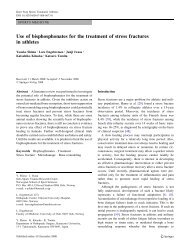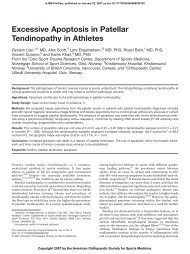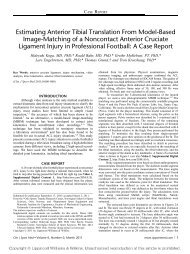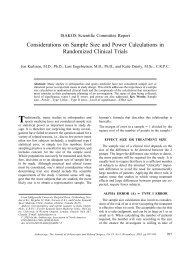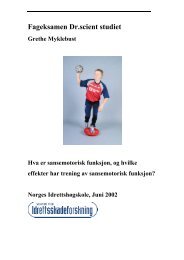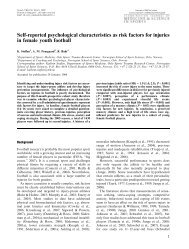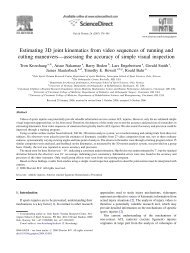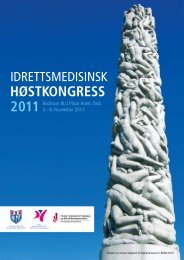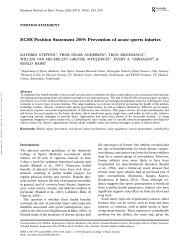The Anatomy of the Medial Part of the Knee
The Anatomy of the Medial Part of the Knee
The Anatomy of the Medial Part of the Knee
Create successful ePaper yourself
Turn your PDF publications into a flip-book with our unique Google optimized e-Paper software.
2004<br />
THE JOURNAL OF BONE & JOINT SURGERY · JBJS.ORG<br />
VOLUME 89-A · NUMBER 9 · SEPTEMBER 2007<br />
T HE ANATOMY OF THE MEDIAL PART OF THE KNEE<br />
oral and meniscotibial portions <strong>of</strong> <strong>the</strong> posteromedial capsule,<br />
and it also had a stout attachment to <strong>the</strong> medial meniscus. Anteriorly,<br />
it merged with <strong>the</strong> posterior fibers <strong>of</strong> <strong>the</strong> superficial<br />
medial collateral ligament. <strong>The</strong> central arm <strong>of</strong> <strong>the</strong> posterior<br />
oblique ligament could be differentiated from <strong>the</strong> superficial<br />
medial collateral ligament by <strong>the</strong> proximal course <strong>of</strong> its fanlike<br />
fibers, which ran more posteriorly toward its femoral<br />
attachment than did <strong>the</strong> fibers <strong>of</strong> <strong>the</strong> superficial medial collateral<br />
ligament, which coursed more anteriorly toward its<br />
femoral attachment (Fig. 6). Its distal attachment was primarily<br />
to <strong>the</strong> posteromedial aspect <strong>of</strong> <strong>the</strong> medial meniscus, <strong>the</strong><br />
meniscotibial portion <strong>of</strong> <strong>the</strong> posteromedial capsule, and <strong>the</strong><br />
posteromedial part <strong>of</strong> <strong>the</strong> tibia.<br />
<strong>The</strong> capsular arm <strong>of</strong> <strong>the</strong> posterior oblique ligament consisted<br />
<strong>of</strong> a thin proximal fascial expansion <strong>of</strong>f <strong>the</strong> anterior aspect<br />
<strong>of</strong> <strong>the</strong> distal part <strong>of</strong> <strong>the</strong> semimembranosus tendon (Fig.<br />
6). It was located posterior and lateral to <strong>the</strong> menisc<strong>of</strong>emoral<br />
capsular attachments <strong>of</strong> <strong>the</strong> central arm and had no fibers that<br />
coursed toward <strong>the</strong> tibia. <strong>The</strong> capsular arm primarily blended<br />
with <strong>the</strong> menisc<strong>of</strong>emoral portion <strong>of</strong> <strong>the</strong> posteromedial joint<br />
capsule and <strong>the</strong> medial aspect <strong>of</strong> <strong>the</strong> oblique popliteal ligament,<br />
and it also attached to <strong>the</strong> s<strong>of</strong>t tissues over <strong>the</strong> medial<br />
gastrocnemius tendon, <strong>the</strong> adductor magnus tendon expansion<br />
to <strong>the</strong> medial gastrocnemius, and <strong>the</strong> adductor magnus<br />
tendon femoral attachment. Qualitatively, it was less stout<br />
overall than <strong>the</strong> central arm, and it did not have any osseous<br />
attachment.<br />
Fig. 4<br />
Illustration <strong>of</strong> <strong>the</strong> superficial medial collateral ligament (sMCL) (medial<br />
aspect, left knee). <strong>The</strong> proximal forceps are under <strong>the</strong> anterior edge <strong>of</strong><br />
<strong>the</strong> femoral portion, and <strong>the</strong> distal hemostat is between <strong>the</strong> proximal<br />
and distal tibial attachments. SM = semimembranosus, and POL =<br />
posterior oblique ligament.<br />
<strong>Medial</strong> Patell<strong>of</strong>emoral Ligament<br />
<strong>The</strong> medial patell<strong>of</strong>emoral ligament was located anterior to,<br />
and in a distinct extra-articular layer from, <strong>the</strong> medial joint<br />
capsule. <strong>The</strong> distal border <strong>of</strong> <strong>the</strong> vastus medialis obliquus<br />
muscle attached along <strong>the</strong> majority <strong>of</strong> <strong>the</strong> proximal edge <strong>of</strong> <strong>the</strong><br />
medial patell<strong>of</strong>emoral ligament (Fig. 8). It was from this proximal<br />
margin that <strong>the</strong> medial patell<strong>of</strong>emoral ligament was consistently<br />
identified. Distally, it could be distinguished as a<br />
distinct thickening within <strong>the</strong> fascial layer, which coursed between<br />
<strong>the</strong> proximal-medial edge <strong>of</strong> <strong>the</strong> patella and its femoral<br />
attachment. <strong>The</strong> medial patell<strong>of</strong>emoral ligament had a broadbased<br />
attachment to <strong>the</strong> superomedial aspect <strong>of</strong> <strong>the</strong> medial<br />
border <strong>of</strong> <strong>the</strong> patella. On <strong>the</strong> average, <strong>the</strong> midpoint <strong>of</strong> <strong>the</strong> medial<br />
patell<strong>of</strong>emoral ligament patellar attachment was located<br />
41.4% <strong>of</strong> <strong>the</strong> length from <strong>the</strong> proximal tip <strong>of</strong> <strong>the</strong> patella along<br />
<strong>the</strong> total patellar length (proximal to distal). <strong>The</strong> average overall<br />
length <strong>of</strong> <strong>the</strong> patella in <strong>the</strong>se knees was 48.4 mm (range,<br />
38.1 to 55.8 mm). <strong>The</strong> ligament <strong>the</strong>n coursed medially toward<br />
<strong>the</strong> femoral attachments <strong>of</strong> <strong>the</strong> adductor magnus tendon and<br />
superficial medial collateral ligament and attached primarily<br />
to s<strong>of</strong>t tissues between <strong>the</strong>se two structures (Fig. 2). <strong>The</strong> me-<br />
Fig. 5<br />
Photograph <strong>of</strong> <strong>the</strong> menisc<strong>of</strong>emoral (MF) and meniscotibial (MT) portions<br />
<strong>of</strong> <strong>the</strong> deep medial collateral ligament (medial aspect, left knee)<br />
with <strong>the</strong> posterior oblique ligament and remaining medial capsule removed.<br />
<strong>The</strong> asterisk indicates <strong>the</strong> femoral attachment site <strong>of</strong> superficial<br />
medial collateral ligament. MM = posterior aspect <strong>of</strong> medial<br />
meniscus, MFC = posterior aspect <strong>of</strong> medial femoral condyle, and<br />
MTP = posterior aspect <strong>of</strong> medial tibial plateau.



